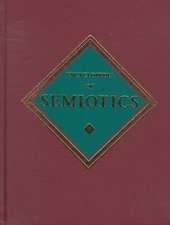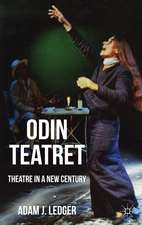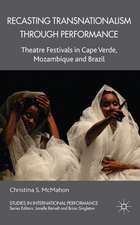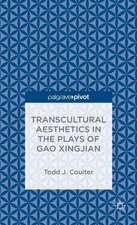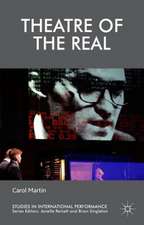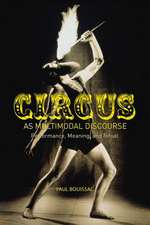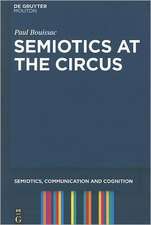The Semiotics of Clowns and Clowning: Rituals of Transgression and the Theory of Laughter: Bloomsbury Advances in Semiotics
Autor Professor Emeritus Paul Bouissacen Limba Engleză Paperback – 20 mai 2015
| Toate formatele și edițiile | Preț | Express |
|---|---|---|
| Paperback (1) | 258.42 lei 6-8 săpt. | |
| Bloomsbury Publishing – 20 mai 2015 | 258.42 lei 6-8 săpt. | |
| Hardback (1) | 832.41 lei 6-8 săpt. | |
| Bloomsbury Publishing – 20 mai 2015 | 832.41 lei 6-8 săpt. |
Din seria Bloomsbury Advances in Semiotics
- 14%
 Preț: 179.13 lei
Preț: 179.13 lei - 22%
 Preț: 271.40 lei
Preț: 271.40 lei - 22%
 Preț: 256.85 lei
Preț: 256.85 lei -
 Preț: 173.71 lei
Preț: 173.71 lei - 18%
 Preț: 238.84 lei
Preț: 238.84 lei - 30%
 Preț: 568.71 lei
Preț: 568.71 lei - 14%
 Preț: 171.77 lei
Preț: 171.77 lei - 14%
 Preț: 1006.79 lei
Preț: 1006.79 lei - 23%
 Preț: 190.96 lei
Preț: 190.96 lei - 23%
 Preț: 198.05 lei
Preț: 198.05 lei - 13%
 Preț: 231.16 lei
Preț: 231.16 lei -
 Preț: 198.22 lei
Preț: 198.22 lei - 13%
 Preț: 232.07 lei
Preț: 232.07 lei - 13%
 Preț: 237.28 lei
Preț: 237.28 lei - 24%
 Preț: 190.16 lei
Preț: 190.16 lei - 8%
 Preț: 299.19 lei
Preț: 299.19 lei - 23%
 Preț: 192.30 lei
Preț: 192.30 lei - 18%
 Preț: 306.47 lei
Preț: 306.47 lei - 22%
 Preț: 257.32 lei
Preț: 257.32 lei - 22%
 Preț: 223.58 lei
Preț: 223.58 lei - 30%
 Preț: 773.39 lei
Preț: 773.39 lei - 22%
 Preț: 226.79 lei
Preț: 226.79 lei - 22%
 Preț: 238.40 lei
Preț: 238.40 lei - 23%
 Preț: 192.73 lei
Preț: 192.73 lei - 22%
 Preț: 237.84 lei
Preț: 237.84 lei - 22%
 Preț: 1007.62 lei
Preț: 1007.62 lei - 8%
 Preț: 131.83 lei
Preț: 131.83 lei - 18%
 Preț: 305.53 lei
Preț: 305.53 lei
Preț: 258.42 lei
Preț vechi: 296.48 lei
-13% Nou
Puncte Express: 388
Preț estimativ în valută:
49.45€ • 51.77$ • 40.92£
49.45€ • 51.77$ • 40.92£
Carte tipărită la comandă
Livrare economică 07-21 aprilie
Preluare comenzi: 021 569.72.76
Specificații
ISBN-13: 9781472532787
ISBN-10: 1472532783
Pagini: 232
Ilustrații: 40 illus
Dimensiuni: 156 x 234 x 13 mm
Greutate: 0.41 kg
Editura: Bloomsbury Publishing
Colecția Bloomsbury Academic
Seria Bloomsbury Advances in Semiotics
Locul publicării:London, United Kingdom
ISBN-10: 1472532783
Pagini: 232
Ilustrații: 40 illus
Dimensiuni: 156 x 234 x 13 mm
Greutate: 0.41 kg
Editura: Bloomsbury Publishing
Colecția Bloomsbury Academic
Seria Bloomsbury Advances in Semiotics
Locul publicării:London, United Kingdom
Caracteristici
Examines what clowns and clowning say about civilization and its systemic rules
Notă biografică
Paul Bouissac is Professor Emeritus at the University of Toronto (Victoria College), Canada. He is a world renowned figure in semiotics and a pioneer of circus studies. He runs the SemiotiX Bulletin [www.semioticon.com/semiotix] which has a global readership.
Cuprins
Introduction1. The Faces of the ClownAppearance and identityThe making of a faceKinds and scales of facial transformations in clownsThe crafting of a clown's make-upThe face of dominanceInterpreting the face of a clownThe modern face of the clownWhen clowns go post-modern2. The Costumes of the ClownsThe clowns' trunksSplendor and sophistication of the whitefaceThe auguste's misfits and tattersSociosemiotics and biosemiotics of clown costumesClowns in drag: cross-dressing and transvestism3. The Clown's WorkshopThe semiotics of artifactsA visit to Charlie Cairoli's workshopWhen clowns play magicClowns as craftsmen and engineersThe clown's barnyard4. The Semiotics of GagsWhat is a gag?Gags in contextRob Torres: a solo clown act in New YorkThe semiotic anatomy of gagsThe physics of gags5. The Game of the RulesThe language of clowningThe straight, the tight, and the looseIdentity: one in two, two in one6. Clown and Trickster Master of tricksToo good to be trueTransgression and consequencesMaster of fireThe trickster and his avatarsUnderstanding tricksters and clownsPeering in the cultural past: a reasoned speculation7. Clowns and Gender Play: Politics and Economy of SexBeyond sex and genderImages of desireAn odd coupleA "normal" coupleA bird taleGender play8. Clowns, Death, and LaughterDeath at the circusDeath of the augusteRealm of the macabre: ghosts, corpses, and skeletonsClowns and death in the arts: laughter at the edge9. Profaning the Sacred The avatars of ClownA grand narrative and its fractal performancesThe sacred and the profanePutting things inside out and upside down10. Clowns without BordersMapping clowns on the worldClowns without borders?Clowning beyond the cultural fencesClowning in JavaThe gentrification of clownsClowns with a missionConclusion: Contribution to the Theory of LaughterWhat is laughter?The meaning of laughterSenseless laughingLaughter as addiction: a hypothesis and an agendaReferences
Recenzii
One of the major contributions of the book is that, after reading it, watching clown performances can never be the same: the author guides us through the semiotics of clowning in such detail that every move and feature of clown acts will be overloaded with meaning(s) for the readers ... [A] reader-friendly book and an invaluable ethnographic approach to an area of study that has been most neglected by (humour and other) scholars ... particularly interesting for humour researchers, especially those who investigate clown performances in or, mostly nowadays, outside circuses.
An important addition to literature on clowns and laughter, and an ambitious attempt to address in transcendent terms the negotiation of meaning at the heart of clown-generated laughter ... Valuable insights into practice abound ... Bouissac's knowledge of and sensitivity to a breadth of cultural contexts allows for fascinating and relevant examinations of time-honored clown routines ... Indeed his book finds its full value in a sustained reflection from a perspective we don't usually encounter: the sign-rich soil beneath our social interaction and the precise manner of its playful overturning by the classic circus clown.
In this book, Paul Bouissac, pioneer and master of the scientific approach to circus arts, demonstrates in a complete and brilliant way, by semiotic, anthropological and cognitive approaches, how the clowning art is a multimodal and complex act of communication, which produces laughter and sense through cognitive and cultural constructions shared by artists and spectators. THE definitive reference to understand clowning!
Bouissac brings his customary rigour and a true respect and love for the art of clowning to the task of discussing what clowns actually do and what it might mean. The full force of semiotic analysis bears generous fruit as Bouissac bases any theoretical analysis or deductions upon actual detailed descriptions of clowns in action. A hugely valuable contribution to the growing field of clown studies and an antidote to the lazy off-the-shelf popular mythologizing about clowning which passes for commentary in many quarters.
An important addition to literature on clowns and laughter, and an ambitious attempt to address in transcendent terms the negotiation of meaning at the heart of clown-generated laughter ... Valuable insights into practice abound ... Bouissac's knowledge of and sensitivity to a breadth of cultural contexts allows for fascinating and relevant examinations of time-honored clown routines ... Indeed his book finds its full value in a sustained reflection from a perspective we don't usually encounter: the sign-rich soil beneath our social interaction and the precise manner of its playful overturning by the classic circus clown.
In this book, Paul Bouissac, pioneer and master of the scientific approach to circus arts, demonstrates in a complete and brilliant way, by semiotic, anthropological and cognitive approaches, how the clowning art is a multimodal and complex act of communication, which produces laughter and sense through cognitive and cultural constructions shared by artists and spectators. THE definitive reference to understand clowning!
Bouissac brings his customary rigour and a true respect and love for the art of clowning to the task of discussing what clowns actually do and what it might mean. The full force of semiotic analysis bears generous fruit as Bouissac bases any theoretical analysis or deductions upon actual detailed descriptions of clowns in action. A hugely valuable contribution to the growing field of clown studies and an antidote to the lazy off-the-shelf popular mythologizing about clowning which passes for commentary in many quarters.

